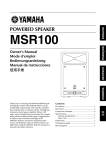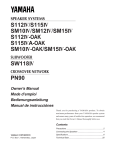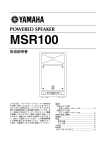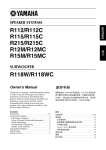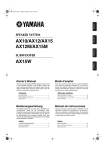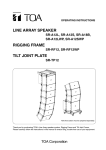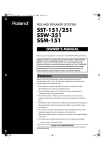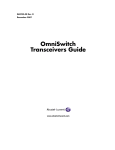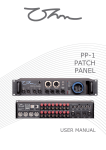Download Yamaha IVN Owner`s manual
Transcript
SPEAKER SYSTEMS S112IVN/S115IVN/S215IVN SM10IVN/SM12IVN/SM15IVN SUBWOOFER SW118IVN/SW215IVN CROSSOVER NETWORK PN90 Owner’s Manual Mode d’emploi Bedienungsanleitung Manual de instrucciónes Thank you for purchasing a YAMAHA product. To obtain maximum performance from your YAMAHA speaker system and ensure many years of trouble-free operation, we recommend that you read this Owner’s Manual thoroughly before use. Contents Precautions ...................................................................... 2 Connecting the Speakers ................................................ 4 Specifications ................................................................... 6 Technical Data ...............................................................25 Precautions AVOID EXCESSIVE HEAT, HUMIDITY, DUST AND VIBRATION MAKE SURE THE POWER IS OFF BEFORE MAKING OR REMOVING CONNECTIONS When choosing a location for your speakers, avoid the fol- Always turn the power switches of system components lowing: OFF prior to connecting or disconnecting cables. Failure to do so may result in damage to speakers as well as to connected equipment. • Direct sunlight, high temperatures (such as near heaters), or excessively low temperatures. • High humidity. DISCONNECT CABLES BEFORE MOVING THE SYS- • Areas subject to excessive dust accumulation and vibration. TEM To prevent short circuits or breakage of cables, always disconnect cables prior to moving system equipment. • Non-level or unstable surfaces. HOW TO POWER UP YOUR SOUND SYSTEM MATCH CONNECTOR POLARITY To avoid damage to your speakers and other parts of your system, when you turn on your system, ALWAYS turn the When using two or more speaker systems, be sure match the polarity (+/–) of the speaker system connectors to those at the amplifier. If the polarities do not match, the sounds power amp on last! This will avoid loud, damaging pops that will annoy your audience, and blow your speakers. When you power down, the amplifier should ALWAYS be produced by the speakers will interfere with each other, making it impossible to achieve a well-balanced sound turned off first to avoid the same problems. field. KEEP THIS OWNER’S MANUAL IN A SAFE PLACE FOR FUTURE REFERENCE To protect your speakers When choosing a power amplifier to use with your speakers, make sure that its power output matches the speakers’ power capacity (refer to the Specifications on Poly Switch All full-range loudspeakers are fitted with a self-resetting poly switch that protects the high-frequency driver from damage caused by excessive power. page 6). Even if the amplifier’s power output is lower than the speakers’ PGM (program) power capacity, the speakers may be damaged when clipping of a high input signal occurs. If a loudspeaker cabinet loses high-frequency output, immediately remove power from the unit and wait for two to three minutes. They should allow the poly switch The following may cause damage to speakers: • Feedback caused when using a microphone. • Continuous high sound pressure level produced by electronic instruments. to reset. Re-apply power and check the performance of the high-frequency driver before continuing with the power reduced to a level that does not cause the poly • Continuous high-power output distorted signals. switch to interrupt the signal. • Popping noises caused by turning on equipment, or by connecting or disconnecting system components On the SW118IVN/SW215IVN sub woofer, the Poly Switch protects the woofer and a similar routine should be followed if its output is lost. while the amplifier is turned on. –2– This product, when used in combination with amplification and/or additional loudspeakers, may be capable of producing sound levels that could cause permanent hearing loss. DO NOT operate at high volume levels or at a level that is uncomfortable. If you experience any discomfort or ringing in the ears, or suspect an hearing loss, you should consult an audiologist. CAUTION! For the five models, S112IVN, S115IVN, SM10IVN, SM12IVN, and SM15IVN, use the TS-30, TS-40, TS-80, or TS-90 speaker stand by Ultimate Support System, Inc. sold separately. When using speaker stands, observe the following precautions to prevent the speaker stands from falling over or the speaker system being dropped. • Use the speaker stands with their legs fully opened. • Do not place more than one speaker on the same speaker stand. • Tighten fastening screws securely. • Remove the speakers from the stands before moving the stands or adjusting their height. • Implement measures to prevent the speaker stands from falling over. • Use the TS-30, TS-40 at no higher than 130 cm for the S112IVN, SM10IVN, SM12IVN and at no higher than 120 cm for the S115IVN and SM15IVN. • Use the TS-80 and TS-90 at no higher than 140 cm for all speaker models. • The top tube of the TS-30 and TS-40 speaker stands has a diameter of 1-1/2", but is tapered to 1-3/8" at the top to fit in the mounting holes on the five models named. If you should remove the top tube from a stand, be sure to insert it with the narrow end up when reassembling. The SW118IVN, SW215IVN subwoofer has a metal socket to allow mounting of a satellite speaker. Do not use a pole longer than 56". Use a pole with an outer diameter of 1-3/ 8". SPEAKER HANDLES The handles on your speakers are for transportation. They are not designed for suspension or hanging. –3– Connecting the Speakers CONNECTION EXAMPLE 1 The illustration below shows audio connections for a standard setup using two speaker systems. DAISY-CHAINED MIXING CONSOLE GRAPHIC EQUALIZER L POWER AMPLIFIER L L SPEAKER SYSTEMS R SPEAKER SYSTEMS R R Daisy-Chaining Speakers Since the speaker systems in this series are equipped with two input terminals that are internally connected in parallel, it is possible “daisy-chain” speakers by connecting the output from the power amplifier to one Neutrik connector, and a second speaker system to the other. We do not recommend connecting more than two 8 speakers in parallel. Two parallel-connected 8 speakers have a total impedance of 4 , which is the minimum that should be connected to one amplifier output channel. The S112IVN, S115IVN, SM10IVN, SM12IVN, SM15IVN and SW118IVN are 8 speakers, and two of these can safely be paralleled on one output. The S215IVN and SW215IVN, however, have an impedance of 4 and should not be parallel-connected with another S215IVN / SW215IVN or any other model. Neutrik NL4FC Plug Wiring If you will be using the Neutrik connectors for speaker input, wire the plugs as shown below. Be sure to use proper speaker cable—NOT shielded instrument or line cable—for all speaker connections. 2– (NO USE) 2+ (NO USE) 1+ : HOT(+) 1– :COLD (–) Neutrik NL4FC connector Caution: Use only unshielded speaker cable with stranded conductors to connect speakers to the speaker terminals on a power amplifier. The use of audio cable not rated as sufficient for the amplifier’s maximum output level can create a potential fire hazard. –4– CONNECTION EXAMPLE 2 This example shows audio connections for a system using SW118IVN or SW215IVN Subwoofers and a PN90 Crossover Network. TWO-CHANNEL POWER AMPLIFIER SPEAKER SYSTEM PN90 L L LEFT MIXING CONSOLE TWO-CHANNEL GRAPHIC EQUALIZER HIGH INPUT OUTPUT SW118IVN or SW215IVN RIGHT L L R R L L LEFT INPUTS TO POWER AMP INPUTS RIGHT R R LEFT LOW INPUT OUTPUT SPEAKER SYSTEM RIGHT R R TWO-CHANNEL POWER AMPLIFIER SW118IVN or SW215IVN • Do not connect the PN90 between the power amplifiers and the SW118IVN, SW215IVN subwoofers, as doing so will damage the equipment. • Although the PN90 has a standard load impedance of 15 k , it can be used with loads between 7.5 and 30 k , allowing use with most power amplifiers. • Since the LOW signal polarity is inverted at the crossover point between the LOW and HIGH signals, be sure to reverse the polarity when connecting the SW118IVN, SW215IVN input connectors to the power amplifier output connectors. This polarity correction must not be made by reversing the polarity of the connections between the PN90 and the power amplifiers, as doing so will damage the equipment. Please reverse the polarity between the power amplifiers and the SW118IVNs, SW215IVNs. • The PN90 uses unbalanced connectors. Use shielded audio cable with high-quality phone plugs to connect the PN90. The balance between the LOW and HIGH signal levels may be adjusted using the power amplifier volume controls. A good starting point is generally achieved for typical sound sources by raising the LOW signal level about 8 dB higher than that of the HIGH signal. –5– Specifications Model SM10IVN Enclosure Speaker Unit LF 10" cone HF 1" driver 12" cone 15" cone 15" cone x 2 2" driver 60 Hz to 16 kHz 150 W 55 Hz to 16 kHz 250 W 42 Hz to 16 kHz 500 W 200 W 400 W 300 W 600 W 500 W 1000 W 1000 W 2000 W 95 dB SPL (1W, 1m) 60˚ 97 dB SPL (1W, 1m) Nominal Impedance 8 Horizontal Dispersion Vertical Crossover Frequency 4 99 dB SPL (1W, 1m) 90˚ 40˚ 1.8 kHz 2 kHz Input Connectors 1.7 kHz 1.5 kHz Neutrik NL4MP x 2 (parallel input) Dimensions (W x H x D) 560 x 339 x 277 mm Weight 12.2 kg S112IVN: 400 x 638 x 318 mm SM12IVN: 643 x 402 x 344 mm S115IVN: 475 x 712 x 362 mm SM15IVN: 720 x 485 x 345 mm S112IVN: 19.3 kg, SM12IVN: 19.5 kg, S115IVN: 27.5 kg, SM15IVN: 26 kg S112IVN, S115IVN 75˚ S215IVN 70 Hz to 20 kHz 100 W PGM MAX Sensitivity Nominal S115IVN/SM15IVN Bass reflex type Frequency Response Power NOISE* Capacity S112IVN/SM12IVN S215IVN 105˚ 500 x 1170 x 600 mm 46 kg SM10IVN, SM12IVN, SM15IVN 102.5˚ 77.5˚ 120˚ H H 30˚ H D W D D W W Model Crossover Frequency Model Enclosure Speaker Unit SW215IVN Bass reflex type 18" cone 15" cone x 2 Frequency Response Power Capacity SW118IVN Recommended Load Impedance Insertion loss 30 Hz to 2 kHz 33 Hz to 2 kHz NOISE* PGM 250 W 500 W 500 W 1000 W MAX 1000 W 8 2000 W 4 96 dB SPL (1W, 1m) 98 dB SPL (1W, 1m) Nominal Impedance Sensitivity Recommended Crossover Frequency Input Connectors PN90 90 Hz, 12 dB/octave (at 15 k load) 15 k 3 dB Input Connectors Output Connectors Dimensions (W x H x D) Weight 1/4" phone jack x 2 1/4" phone jack x 4 227 x 38 x 76 mm 0.6 kg PN90 6.2 90 Hz, 12 dB/octave Neutrik NL4MP x 2 (parallel input) Dimensions (W x H x D) Weight 542 x 654 x 791 mm 32.4 kg SW118IVN 1115 x 520 x 600 mm 63.5 kg 216 W SW215IVN H H D D W 63.5 H Unit: mm ✻ : EIA RS-426 Specifications subject to change without notice W –6– D Technical Data / Données techniques Technische Daten / Datos técnicos Frequency Response / Impedance Réponse en fréquence/impédance Frequenzgang/Impedanz Respuesta en frecuencia/Impedancia • SM10 IVN • S115IVN/SM15 IVN 100 100 RESPONSE(dB) 110 90 80 16 70 60 4 100 1k 80 16 70 8 20 90 60 10k 8 4 20 100 FREQUENCY(Hz) • S215IVN 100 100 90 80 16 70 RESPONSE(dB) 110 RESPONSE(dB) 110 90 8 70 4 100 1k 16 80 8 20 60 10k 4 2 20 100 FREQUENCY(Hz) 100 100 90 80 16 70 RESPONSE(dB) 110 RESPONSE(dB) 10k • SW215IVN 110 4 100 1k 90 16 80 8 70 8 20 1k FREQUENCY(Hz) • SW118IVN 60 10k FREQUENCY(Hz) • S112IVN/SM12IVN 60 1k 60 10k FREQUENCY(Hz) 4 2 20 100 1k FREQUENCY(Hz) – 25 – 10k Additions RESPONSE(dB) 110 Horizontal Directivity / Directivité horizontale Abstrahlung horizontal / Directividad horizontal • SM10 IVN 40 50 270° 40 12 0° 10 0 10 0 10 0 0 10 0 10 0 10 21 0° 20 30 40 30 40 30 40 180° 180° 15 21 0° 20 0° 24 0° 0° 24 30 0° 30 15 20 12 0° 10 50 90° 0 50 90° ° 0 60 10 ° 20 30 0° 60 30 30 ° 40 0° 33 50 270° • 4kHz • 8kHz • 16kHz 30 ° 30 0° 0° 0° 0° 33 • 500Hz • 1kHz • 2kHz • S112IVN/SM12IVN 20 30 40 50 270° 40 12 0° 20 20 0° 24 0° 15 180° 180° 21 0° 15 21 0° 0° 0° 24 30 12 0° 10 50 90° 0 50 90° ° 0 60 10 ° 20 30 0° 60 30 30 ° 40 0° 33 50 270° • 4kHz • 8kHz • 16kHz 30 ° 30 0° 0° 0° 0° 33 • 500Hz • 1kHz • 2kHz • S115IVN/SM15IVN 0° 30 40 50 270° 12 0° 30 20 20 0° 24 0° 15 180° 180° 21 0° 15 21 0° 0° 0° 24 40 12 0° 20 50 90° 10 50 90° ° 0 60 0 ° 10 30 0° 60 20 30 ° 30 0° 40 0° 33 30 0° 50 270° • 4kHz • 8kHz • 16kHz 30 ° 0° 33 • 500Hz • 1kHz • 2kHz • S215IVN 40 50 270° 12 0° 20 10 0 0 21 0° 180° 180° 15 21 0° 30 10 20 0° 24 0° 0° 24 40 0° 30 15 20 – 26 – 30 40 12 0° 10 50 90° 0 50 90° ° 0 60 10 ° 20 30 0° 60 30 30 ° 40 0° 33 50 270° • 4kHz • 8kHz • 16kHz 30 ° 30 0° 0° 0° 0° 33 • 500Hz • 1kHz • 2kHz Vertical Directivity / Directivité verticale Vertikale Richtcharkteristik / Directividad vertical • SM10 IVN 40 50 270° 12 0° 30 10 0 10 0 10 0 0 10 0 10 0 10 21 0° 20 30 40 30 40 30 40 180° 180° 15 21 0° 20 0° 24 0° 0° 24 40 0° 30 15 20 12 0° 10 50 90° 0 50 90° ° 0 60 10 ° 20 30 0° 60 30 30 ° 40 0° 33 50 270° • 4kHz • 8kHz • 16kHz 30 ° 30 0° 0° 0° 0° 33 • 500Hz • 1kHz • 2kHz • S112IVN/SM12IVN 20 30 40 50 270° 12 0° 30 20 0° 180° 180° 15 21 0° 15 21 0° 20 0° 24 0° 0° 24 40 12 0° 10 50 90° 0 50 90° ° 0 60 10 ° 20 30 0° 60 30 30 ° 40 0° 33 50 270° • 4kHz • 8kHz • 16kHz 30 ° 30 0° 0° 0° 0° 33 • 500Hz • 1kHz • 2kHz • S115IVN/SM15IVN 50 270° 12 0° 30 21 0° 20 180° 180° 15 21 0° 20 0° 24 0° 0° 24 40 • S215IVN 40 50 270° 12 0° 20 10 0 0 21 0° 180° 180° 15 21 0° 30 10 20 0° 24 0° 0° 24 40 0° 30 15 20 – 27 – 30 40 12 0° 10 50 90° 0 50 90° ° 0 60 10 ° 20 30 0° 60 30 30 ° 40 0° 33 50 270° • 4kHz • 8kHz • 16kHz 30 ° 30 0° 0° 0° 0° 33 • 500Hz • 1kHz • 2kHz Additions 40 0° 30 15 20 12 0° 10 50 90° 0 50 90° ° 0 60 10 ° 20 30 0° 60 30 30 ° 40 0° 33 50 270° • 4kHz • 8kHz • 16kHz 30 ° 30 0° 0° 0° 0° 33 • 500Hz • 1kHz • 2kHz Yamaha Manual Library http://www2.yamaha.co.jp/manual/english/ M.D.G., Pro Audio & Digital Musical Instrument Division, Yamaha Corporation © 2002 Yamaha Corporation CJY0333 209AP A0 Printed in Taiwan











